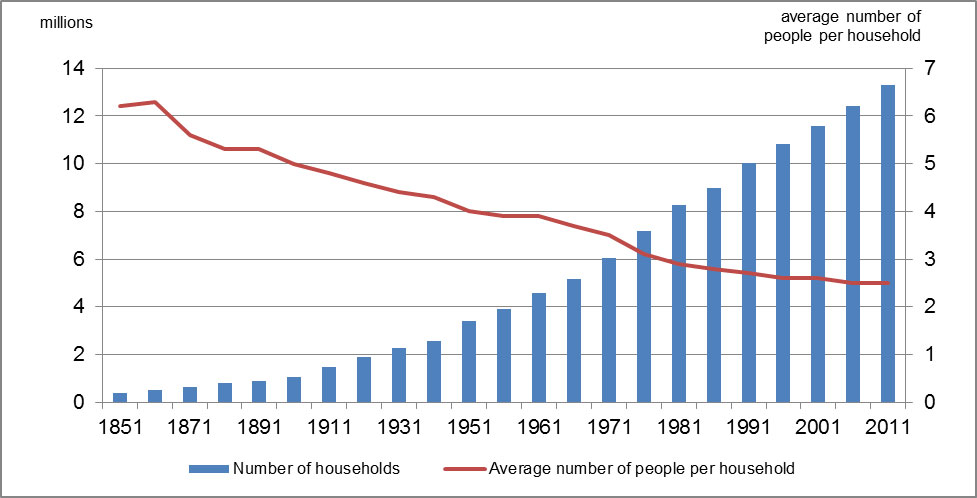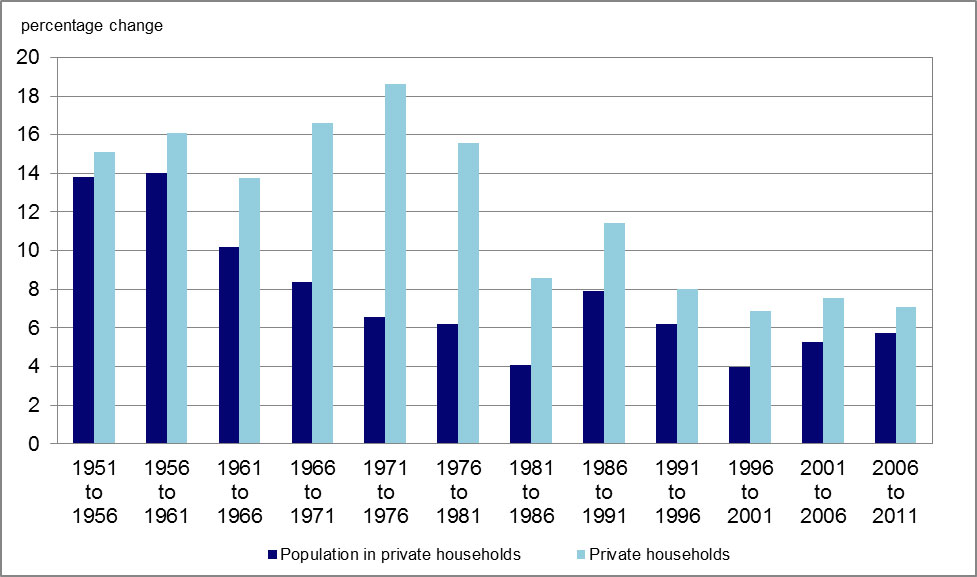The shift to smaller households over the past century

Household size in Canada has declined over time. While households in the 1950s and 1960s were much larger, often comprised of two parents with children, nowadays households are likely to be much smaller on average—with most comprised of one or two people.
These shifting patterns are the result of the social and historical changes that have reshaped Canadian society over the same period.
Smaller households have implications for private life and for society in general. For instance, smaller families and more people living alone have helped spur changes to the housing market as well as to the way that companies market their products. The trend also means that the care and support of young children or older Canadians is spread among a smaller circle of people.
Increase in number of households, but decline of average household size
In 1851, there were about 375,000 households in Canada, a number which would continue to rise over the next 160 years. In 1941, there were 2.6 million households, increasing about five-fold during the following seven decades to 13.3 million in 2011.
Chart 1: Number of households and average number of people per household, Canada, 1851 to 2011

Sources: 1851 to 1921—B. Ram. 1990. New Trends in the Family. Statistics Canada Catalogue no. 91-535E. Appendix Table 5.1. 1931 to 1971—S. Wargon. 1979. Canadian Households and Families. Statistics Canada, Catalogue no. 99-753. 1976 to 2011—Statistics Canada, censuses of population, 1976 to 2011.
Description for Chart 1
| Year | Number of households | Average number of people per household |
|---|---|---|
| 1851 | 374,491 | 6.2 |
| 1861 | 491,687 | 6.3 |
| 1871 | 622,719 | 5.6 |
| 1881 | 800,410 | 5.3 |
| 1891 | 900,080 | 5.3 |
| 1901 | 1,058,564 | 5.0 |
| 1911 | 1,482,980 | 4.8 |
| 1921 | 1,897,127 | 4.6 |
| 1931 | 2,252,729 | 4.4 |
| 1941 | 2,575,744 | 4.3 |
| 1951 | 3,409,284 | 4.0 |
| 1956 | 3,923,646 | 3.9 |
| 1961 | 4,554,736 | 3.9 |
| 1966 | 5,180,473 | 3.7 |
| 1971 | 6,041,302 | 3.5 |
| 1976 | 7,166,095 | 3.1 |
| 1981 | 8,281,531 | 2.9 |
| 1986 | 8,991,672 | 2.8 |
| 1991 | 10,018,267 | 2.7 |
| 1996 | 10,820,050 | 2.6 |
| 2001 | 11,562,975 | 2.6 |
| 2006 | 12,435,520 | 2.5 |
| 2011 | 13,320,615 | 2.5 |
While the number of households has grown, the average number of people in each household has dropped. In 1851, the average number of persons per household was 6.2, decreasing to 4.3 persons in 1941 and falling further to 2.5 persons in 2011.
Large households common in early 20th Century
In the early 20th Century, families often had many children, resulting in large households. However, during this era, households were often flexible, expanding and contracting as the need arose. It was not unusual for households to include relatives, boarders or other individuals, either temporarily or on a longer-term basis.
Large households comprised of five or more people accounted for 38.2% of all households in 1941, falling to 8.4% in 2011.
Chart 2: Distribution (in percentage) of private households by number of people, Canada, 1941 to 2011

Description for Chart 2
| 1941 | 1951 | 1961 | 1971 | 1981 | 1991 | 2001 | 2011 | |
|---|---|---|---|---|---|---|---|---|
| One person | 6.0 | 7.4 | 9.3 | 13.4 | 20.3 | 22.9 | 25.7 | 27.6 |
| Two people | 18.4 | 20.9 | 22.2 | 25.3 | 29.0 | 31.4 | 32.6 | 34.1 |
| Three people | 19.5 | 20.2 | 17.8 | 17.3 | 17.5 | 17.4 | 16.2 | 15.6 |
| Four people | 17.9 | 18.9 | 18.4 | 17.6 | 18.7 | 17.7 | 16.0 | 14.3 |
| Five people or more | 38.2 | 32.7 | 32.3 | 26.4 | 14.6 | 10.6 | 9.5 | 8.4 |
The shift away from large households and toward smaller households is part of a long-term trend. Although the proportion of large households fell steadily between 1941 and 2011, households of five or more people remained the most common household size until 1976, when two-person households became most prevalent.
For 35 years, the two-person household—including variations such as a couple without children, a parent and child or two roommates—has been the most common household size, nearly doubling in share from 18.4% in 1941 to 34.1% in 2011.
More one-person households than households of five or more people since 1981
The 1981 Census marked the first time that one-person households (20.3% of all households) surpassed households of five or more people (14.6%). Since then, the gap has continued to widen.
In 2011, households consisting of one person accounted for 27.6% of all households—nearly a five-fold increase from 6.0% in 1941.
In addition to the decline in the overall size of households, there have also been changes in their composition. For the first time in 2011, there were more one-person households (27.6%) than couple households with children (26.5%).
Many reasons for shift to smaller households
There are many reasons that may account for households becoming smaller over time, including lower fertility or no children present in the home, either because household members have never had children, have had fewer children, or their children have grown and established their own independent households.
In addition, relatively high rates of separation and divorce—at least partially owing to broadened divorce legislation in 1968, and again in 1986—are likely to produce two smaller households after the dissolution of a larger one. In fact, during the five-year intervals between 1966 and 1986, growth in the number of private households was about twice as rapid as it was for the population in private households.
Chart 3: Percentage change in the population in private households and in the number of private households, Canada, 1951-1956 to 2006-2011

Description for Chart 2
| Year | Population in private households | Private households |
|---|---|---|
| 1951 to 1956 | 13.8 | 15.1 |
| 1956 to 1961 | 14.0 | 16.1 |
| 1961 to 1966 | 10.2 | 13.7 |
| 1966 to 1971 | 8.4 | 16.6 |
| 1971 to 1976 | 6.6 | 18.6 |
| 1976 to 1981 | 6.2 | 15.6 |
| 1981 to 1986 | 4.1 | 8.6 |
| 1986 to 1991 | 7.9 | 11.4 |
| 1991 to 1996 | 6.2 | 8.0 |
| 1996 to 2001 | 4.0 | 6.9 |
| 2001 to 2006 | 5.3 | 7.6 |
| 2006 to 2011 | 5.7 | 7.1 |
Population aging and increasing life expectancy can also result in smaller households. Today, people are more likely to live in private households, rather than collective dwellings, until well into their senior years. Most seniors either live alone or as part of a couple.
Slightly smaller shares of three- and four-person households
While there has been a shift in the relative proportion of both large and small households over time, changes in the shares of households comprised of three or four people have been more moderate.
Three-person households decreased from 19.5% in 1941 to 15.6% in 2011, with a slight increase in proportion in 1951, during the baby boom.
Households comprised of four persons ranged from 18% to 19% from 1941 to 1991, decreasing to 14.3% in 2011.
Definitions
Household size: Refers to the number of people per household.
Private households: Refers to a person or a group of persons who occupy the same dwelling and do not have a usual place of residence elsewhere in Canada. It may consist of a family group (census family) with or without other persons, of two or more families sharing a dwelling, of a group of unrelated persons, or of one person living alone. Every person is a member of one and only one household. Household counts from 1851 to 1921 include private and collective households and household counts from 1931 to 2011 refer to private households only.
Couple households with children: Refers to couples with at least one child aged 24 and younger.
Couple households without children: Refers to couples without any children aged 24 and younger.
References
Statistics Canada. 2014. Canadian Demographics at a Glance. Catalogue no. 91-003-X.
Milan, A. and N. Bohnert. 2012. Canadian households in 2011: Type and growth, Census in Brief, Statistics Canada Catalogue no. 98-312-X-2011003.
Milan, A. and N. Bohnert. 2012. Fifty years of families in Canada: 1961 to 2011, Census in Brief, Statistics Canada Catalogue no. 98-312-X-2011003.
Milan, A. 2000. One hundred years of families, Canadian Social Trends, Statistics Canada Catalogue no. 11-008.
Ram, B. 1990. Current Demographic Analysis: New Trends in the Family. Statistics Canada Catalogue no. 91-535E.
Wargon, S.T. 1979. Canadian Households and Families. Statistics Canada Catalogue no. 99-753.
Contact information
To enquire about the concepts, methods and data quality in this publication, contact Anne Milan (613-220-5440), Demography Division.
- Date modified: